Handgun
This article's tone or style may not reflect the encyclopedic tone used on Wikipedia. (April 2022) |
A handgun is a firearm designed to be usable with only one hand.[1] It is distinguished from a long gun (i.e. carbine, rifle, shotgun, submachine gun, or machine gun) which needs to be held by both hands and braced against the shoulder. Handguns have shorter effective ranges compared to long guns, and are much harder to shoot accurately. While most early handguns are single-shot pistols, the two most common types of handguns used in modern times are revolvers and semi-automatic pistols, although other handguns such as derringers and machine pistols also see infrequent usage.
Before commercial
Definition
The
Among the
The
The
- is reasonably capable of being carried or concealed about the person; or
- is reasonably capable of being raised and fired by one hand; or
- does not exceed 65 centimetres (26 in) in length measured parallel to the barrel.[8]
History
Hand cannons
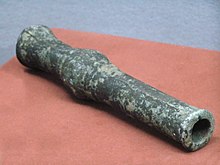
Firearms started in China where gunpowder was first developed. The oldest known bronze barrel handgun is the Heilongjiang hand cannon, in 1288.[9] It is 34 cm (13.4 inches) long without a handle and weighs 3.55 kg (7.83 pounds). The diameter of the powder chamber is 6.6 cm (2.6 inches)[10] while the diameter of the interior at the end of the barrel is 2.5 cm (1.0 inch).[11] The barrel is the lengthiest part of the hand cannon at 6.9 inches long.[12]
The hand cannon has a bulbous base at the
In 1432, Joseon dynasty under the reign of Sejong the Great introduced the world's first handgun named se-chongtong (세총통). Se-chongtong has a total length of 13.8 cm, an inner diameter of 0.9 cm, and an outer diameter of 1.4 cm. Se-chongtong is held by cheolheumja (철흠자, iron tong-handle), which allows quick change barrel for the next shot, and fires chase-jeon (차세전, a type of standardized arrow of Joseon) with a maximum fatal range of 200 footsteps (≈250 meters). Initially, Joseon considered the gun as a failed project due to its short effective range, but se-chongtong quickly saw usage after fielding to the frontier provinces starting in June 1437. Se-chongtong was used by both soldiers of different units and civilians, including women and children, as a personal defense weapon. The gun was notably used by chetamja (체탐자, special reconnaissance), whose mission was to infiltrate enemy territory, and by carabiniers carrying multiple guns benefited from its compact size.[16][17][18]
Matchlocks

The matchlock appeared in Europe in the mid-15th century.[19] The matchlock was the first mechanism invented to facilitate the firing of a hand-held firearm. The classic European matchlock gun held a burning slow match in a clamp at the end of a small curved lever known as the serpentine. Upon the pulling of a lever (or in later models a trigger) protruding from the bottom of the gun and connected to the serpentine, the clamp dropped down, lowering the smoldering match into the flash pan and igniting the priming powder. The flash from the primer traveled through the touch hole igniting the main charge of propellant in the gun barrel.
On the release of the lever or trigger, the spring-loaded serpentine would move in reverse to clear the pan. For obvious safety reasons, the match would be removed before reloading the gun. Both ends of the match were usually kept alight in case one end should be accidentally extinguished.
Wheellocks

The wheellock was the next major development in firearms technology after the matchlock and the first self-igniting firearm. Its name comes from the rotating steel wheel which generates the ignition. Developed in Europe around 1500, it was used alongside the matchlock.
The wheellock works by spinning a spring-loaded steel wheel against a piece of pyrite to generate intense sparks, which ignite gunpowder in a pan, which flashes through a small touchhole to ignite the main charge in the firearm's barrel. The pyrite is clamped in vise jaws on a spring-loaded arm (or "dog"), which rests on the pan cover. When the trigger is pulled, the pan cover is opened, and the wheel is rotated, with the pyrite pressed into contact.
A close modern analogy of the wheellock mechanism is the operation of a cigarette lighter, where a toothed steel wheel is spun in contact with a piece of sparking material to ignite the liquid or gaseous fuel.
A wheellock firearm had the advantage that it could be instantly readied and fired even with one hand, in contrast to the then-common matchlock firearms, which required an operator to prepare a burning cord of slow match and demanded the operator's full attention and two hands to operate. On the other hand, wheellock mechanisms were complex to make, making them relatively expensive.
Flintlocks


A flintlock is a general term for any firearm that uses a flint-striking ignition mechanism. The term may also apply to a particular form of the mechanism itself, which was introduced in the early 17th century, and rapidly replaced earlier firearm-ignition technologies.
Flintlock pistols were used as self-defense weapons and as military arm. Their effective range was short, and they were frequently used as an adjunct to a sword or cutlass. These pistols were usually smoothbore although some rifled pistols were produced.
Flintlock pistols came in a variety of sizes and styles which often overlap and are not well defined; many of the names used were applied by collectors and dealers long after the pistols were obsolete. The smallest were less than 15 cm (5.9 inches) long and the largest were over 51 cm (20 inches). From around the beginning of the 1700s the larger pistols got shorter so that by the late 1700s the largest were closer to 41 cm (16 inches) long. The smallest would fit into a typical pocket or a hand-warming muff and could easily be carried.
The largest sizes would be carried in holsters across a horse's back just ahead of the saddle. In-between sizes included the coat pocket pistol, or coat pistol, which would fit into a large pocket, coach pistols, meant to be carried on or under the seat of a coach in a bag or box, and belt pistols, sometimes equipped with a hook designed to slip over a belt or waistband. Larger pistols were called horse pistols.
A notable mechanical development of the flintlock pistol was the English duelling pistol; it was highly reliable, water resistant, and accurate. External decoration was typically minimal but the internal works were often finished to a higher degree of craftsmanship than the exterior. Duelling pistols were the size of the horse pistols of the late 1700s, around 41 cm (16 inches) long and were usually sold in pairs along with accessories in a wooden case with compartments for each piece.
Caplocks
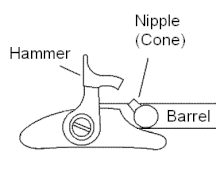
The caplock mechanism or percussion lock was developed in the early 19th century and used a percussion cap struck by the hammer to set off the main charge, rather than using a piece of flint to strike a steel frizzen. They succeeded the flintlock mechanism in firearm technology.
The rudimentary percussion system was developed by Reverend Alexander John Forsyth as a solution to the problem that birds would startle when smoke puffed from the powder pan of his flintlock shotgun, giving them sufficient warning to escape the shot.[20]
His invention of a fulminate-primed firing mechanism deprived the birds of their early warning system, both by avoiding the initial puff of smoke from the flintlock powder pan, as well as shortening the interval between the trigger pull and the shot leaving the muzzle. Forsyth patented his ignition system in 1807. However, it was not until after Forsyth's patents expired that the conventional percussion cap system was developed.
The caplock offered many improvements over the flintlock. The caplock was easier to load, more resistant to weather, and was much more reliable than the flintlock. Many older flintlock weapons were later converted into caplocks so that they could take advantage of this increased reliability.[20]
The caplock mechanism consists of a hammer, similar to the hammer used in a flintlock, and a nipple (sometimes referred to as a "cone"), which holds a small percussion cap. The nipple contains a tube that goes into the barrel. The percussion cap contains a chemical compound called mercury fulminate or fulminate of mercury, the chemical formula of which is Hg(ONC)2.[20] It is made from mercury, nitric acid, and alcohol. When the trigger releases the hammer, it strikes the cap, causing the mercuric fulminate to explode. The flames from this explosion travel down the tube in the nipple and enter the barrel, where they ignite the main powder charge.[20]
Revolvers
Percussion era

In 1836,
Colt would go on to make a series of improved revolvers. The
The
The
Metallic cartridge era

The
The Smith & Wesson Model No. 2 Army is a 6-shot, .32 caliber revolver, intended to combine the small size and convenience of the Smith & Wesson Model 1 .22 rimfire with a larger more effective cartridge. It was manufactured 1861–1874, with a total production of 77,020 units.
The

The
In 1889, Colt introduced the Model 1889, the first truly modern double action revolver, which differed from earlier double action revolvers by having a "swing-out" cylinder, as opposed to a "top-break" or "side-loading" cylinder. Swing out cylinders quickly caught on, because they combined the best features of earlier designs. Top-break actions gave the ability to eject all empty shells simultaneously and exposed all chambers for easy reloading, but having the frame hinged into two halves weakened the gun and negatively affected accuracy due to lack of rigidity. "Side-loaders", like the earlier Colt Model 1871 and 1873 gave a rigid frame, but required the user to eject and load one cylinder at a time, as they rotated the cylinder to line each chamber up with the side-mounted loading gate.[29]

Smith & Wesson followed 7 years later with the ''Hand Ejector, Model 1896'' in .32 S&W Long caliber, followed by the very similar, yet improved, Model 1899 (later known as the Model 10), which introduced the new .38 Special cartridge. The Model 10 went on to become the best selling handgun of the 20th century, at 6,000,000 units, and the .38 Special is still the most popular chambering for revolvers in the world. These new guns were an improvement over the Colt 1889 design since they incorporated a combined center-pin and ejector rod to lock the cylinder in position. The 1889 did not use a center pin and the cylinder was prone to move out of alignment.[29]
The Smith & Wesson Model 36 is a 5 shot, revolver chambered for .38 Special. It is one of several models of "J-frame" Smith & Wesson revolvers. It was introduced in 1950, and is still in production. The Model 36 was designed in the era just after World War II, when Smith & Wesson stopped producing war materials and resumed normal production. For the Model 36, they sought to design a revolver that could fire the more powerful .38 Special round in a small, concealable package. Since the older I-frame was not able to handle this load, a new frame was designed, which became the Smith & Wesson J-frame.
Magnum era
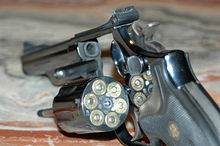
The inventions of the metallic cartridge and then smokeless powder had allowed for dramatic improvements in handgun ballistics. Standardization and adherence to cartridge standards originating in the black powder cartridge era resulted in cartridge capacity in excess of peak combustion pressure standards.
Derringers
The original
The term derringer (
Daniel Moore patented a single shot metallic cartridge
The
While the classic Remington design is a
The
Semi-automatic pistols
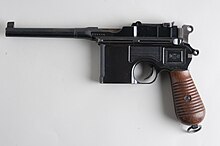
In 1896, Paul Mauser introduced the Mauser C96, the first mass-produced and commercially successful semi-automatic pistol, which uses the recoil energy of one shot to reload the next. The distinctive characteristics of the C96 are the integral 10-round, box magazine in front of the trigger, the long barrel, the wooden shoulder stock which gives it the stability of a short-barreled rifle and doubles as a holster or carrying case, and a unique grip shaped like the handle of a broom. The grip earned the gun the nickname "broomhandle" in the English-speaking world, because of its round wooden handle.
The
The
The
The
The
The
The
- There was no feed ramp between the magazine and the chamber (a Beretta innovation in pistols). In addition, to a 15-round "double-stacked" magazine design,
- It was the first Beretta design to use a magazine release located to the rear of the trigger guard, similar to the Colt M1911.
The
in 1985.The
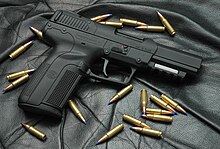
The
- Lightweight polymer-based weapon with a large magazine capacity.
- Ambidextrous controls, low recoil.
- Ability to penetrate body armor when using certain types of ammunition.[63]
The Five-seveN is currently in service with military and police forces in over 40 nations.
Machine pistols
A machine pistol is generally defined as a handgun capable of fully automatic or
3D printed handguns
3D printed firearms are firearms that can be produced with a 3D printer. These kind of firearms are generally used for prototyping during the development of conventional firearms.
This section is empty. You can help by adding to it. (April 2022) |
Overview of gun laws by nation
Many handguns are easily concealed – this has led to laws applying specifically to handgun ownership and the legality of carrying or concealing a handgun whilst in a public setting. Gun laws broadly group gun types into handgun, long guns and to what degree they are automatic. A large number of countries require reasonable grounds for gun ownership and operate permit systems for different gun types.
See also
- Action
- Antique firearms
- Gunspinning
- Gun ownership
- Handgun effectiveness
- Handgun hunting
- List of Bianchi Cup champions
- List of countries by firearm-related death rate
- List of pistols
- Machine pistol
- Pistol
- Pistol-whipping
- Pocket pistol
- Small arms
- Target shooting
References
- ^ "Definition of HANDGUN". www.merriam-webster.com. Retrieved 2019-04-05.
- ^ Cary, Lucian (1961). The Colt GunBook. Greenwich, Connecticut, US: Fawcett Publications. p. 3.
- ISBN 0-8147-1879-5.
- Encyclopaedia Britannica. Retrieved 2022-10-15.
- ^ "Handgun". Merriam-Webster. Retrieved 2022-10-15.
- ^ "Terminology & Nomenclature". Bureau of Alcohol, Tobacco, Firearms and Explosives. Retrieved 2022-10-15.
- ^ "Part III – Firearms and Other Weapons". Department of Justice Canada. Retrieved 2022-10-15.
- ^ "Firearms Act 1996 – Sect 3 Definitions".
- ^ a b Needham 1987, p. 293.
- ^ Chase 2003, p. 32.
- ^ Needham 1987, p. 290.
- ^ a b Chase 2003, p. 32; Needham 1987, p. 293.
- ^ a b Needham 1987, p. 289.
- ^ Lorge 2008, p. 69; Needham 1987, p. 293.
- ^ Needham 1987, p. 289; Needham 1987, p. 330.
- ^ "세총통(細銃筒) – 한국민족문화대백과사전". Encyclopedia of Korean Culture. Retrieved 2022-02-25.
- ^ "보물 세총통 (細銃筒)". Cultural Heritage Administration (in Korean). Retrieved 2022-02-25.
- ^ 【ENG SUB】세계최초 권총형 총통 '세총통' feat. 화력대왕 '세종' Se-Chongtong, the Smallest of Korean Hand Cannons, retrieved 2022-02-25
- S2CID 141794220.
- ^ ISBN 0-89689-390-1.
- ISBN 0-89660-011-4.
- ^ Hounshell, David A. From the American System to Mass Production, 1800–1932, p. 47
- ^ Hogg, Ian V. (1987). Weapons of the Civil War. New York: Military. Print.
- ISBN 0-87349-767-8.
- ISBN 1-58574-721-1.
- ^ "The Gun that Won the West". Colt.
- ISBN 978-0896895348.
- ^ Venturino, Mike (January 2014). "Colt .45 Peacemaker". Guns Magazine. Archived from the original on 2017-05-26. Retrieved 2018-01-09.
- ^ ISBN 978-1-85109-470-7.
- ^ JL, JB. "Stuff You Gotta Watch – Dirty Harry". thestuffyougottawatch.com. Retrieved 20 September 2018.
- ^ ISBN 978-1-4402-2651-9. 410–412
- ISBN 978-0-486-42161-2.
- ISBN 978-0-89689-534-8.
- ^ "Remington .41 Double Derringer". American Rifleman. March 24, 2014. Retrieved 2017-07-22.
- ISBN 978-1-59228-690-4.
- ISBN 978-0-89689-647-5.
- ^ ISBN 978-1-4402-1743-2.
- ^ Fitzsimons, Bernard, ed. (1977). "Luger". The Illustrated Encyclopedia of Weapons and Warfare. Vol. 16. London: Phoebus. p. 1778.
- ^ a b c Datig, Fred A., The Luger Pistol, Gun Digest, 1957 ed., Chicago Illinois: Edward Keogh Co. Inc. (1956) pp. 164–165
- ^ "DWM Luger P-08 Pistol". chuckhawks.com. Retrieved 12 May 2017.
- ISBN 978-1-60170-013-1.
- ^ durysguns.com (2006-01-14). "Which Handgun Round Has the Best Stopping Power?". Retrieved 2006-01-14.
- ISBN 978-0-89689-525-6.
- ISBN 978-9-03661-510-5.
- ^ "James Bond's Walther PPK". CIA Museum. 8 November 2007. Archived from the original on 9 January 2008. Retrieved 15 January 2015.
- ^ "About Walther". Walther Arms. Archived from the original on 5 June 2014. Retrieved 5 June 2014.
- ^ ISBN 978-1-58663-762-0.
- ^ "Walther PP and PPK self-loading pistols (Germany)". Jane's Infantry Weapons. Janes.com. 28 February 2012. Archived from the original on 22 March 2011. Retrieved 7 November 2012.
- ^ Arnold, David W. (2010-09-24). "Classic Handguns of the 20th Century: The Browning HI-Power". Handguns Magazine. Retrieved 2010-01-19.
- ISBN 1-84065-245-4.
- ISBN 978-3000050916.
- ^ David Higginbotham. "The HK VP70 The First Polymer Framed Pistol". Guns.com. Retrieved 2013-11-10.
HK says the VP [...] means Volks Pistole or People's Pistol [...] This is where another (erroneous) name for the pistol comes from. Vollautomatische Pistole.
- ISBN 978-1-4402-2652-6.
Around 1970, Heckler & Koch developed the selective-fire VP70 (VolksPistole: People's Pistol) with the reported hope that it would be chosen to arm village militias in Vietnam.
- OCLC 7572377.
- OCLC 51024327.
- OCLC 26280979.
- ^ "GLOCK Police and Law Enforcement Firearms | Police Pistols | GLOCK USA". us.glock.com. Retrieved 2017-10-18.
- ISBN 978-0896896420.
- ^ Glock: The Rise of America's Gun by Paul M. Barret
- FNH USA. 2009. Retrieved August 31, 2012.
- ISBN 978-0-00-712760-3.
- ISBN 978-2-87415-877-3.
- ^ Bahde, Dave (November 2009). "FNH Five-seveN ODG 5.7×28mm". Combat Handguns. Retrieved November 28, 2009.
- ISSN 1407-1746), Nr. 3/4 (132/133), p. 103.
- ^ Wood, J.B. (26 June 2009). "FNH USA Five-seveN Pistol 5.7×28mm". Tactical Life. Retrieved October 18, 2009.
- ISBN 978-0-7106-2869-5.
- ^ Grevillius, Nils (September 11, 2006). "One Hot Number". Guns & Ammo, Vol. 50 (No. 10): pp 48–53.
Works cited
- Chase, Kenneth Warren (2003). Firearms: A Global History to 1700. Cambridge University Press. ISBN 978-0-521-82274-9.
- Lorge, Peter (2008). The Asian Military Revolution: From Gunpowder to the Bomb. Cambridge University Press. ISBN 978-0-521-84682-0.
- Needham, Joseph (1987). Science and Civilisation in China: Military Technology: The Gunpowder Epic, Volume 5, Part 7. Cambridge University Press. ISBN 978-0-521-30358-3.
External links
- Interactive Illustrated Pistol
- Ballistics By The Inch – Relationship between barrel length and bullet velocity.
